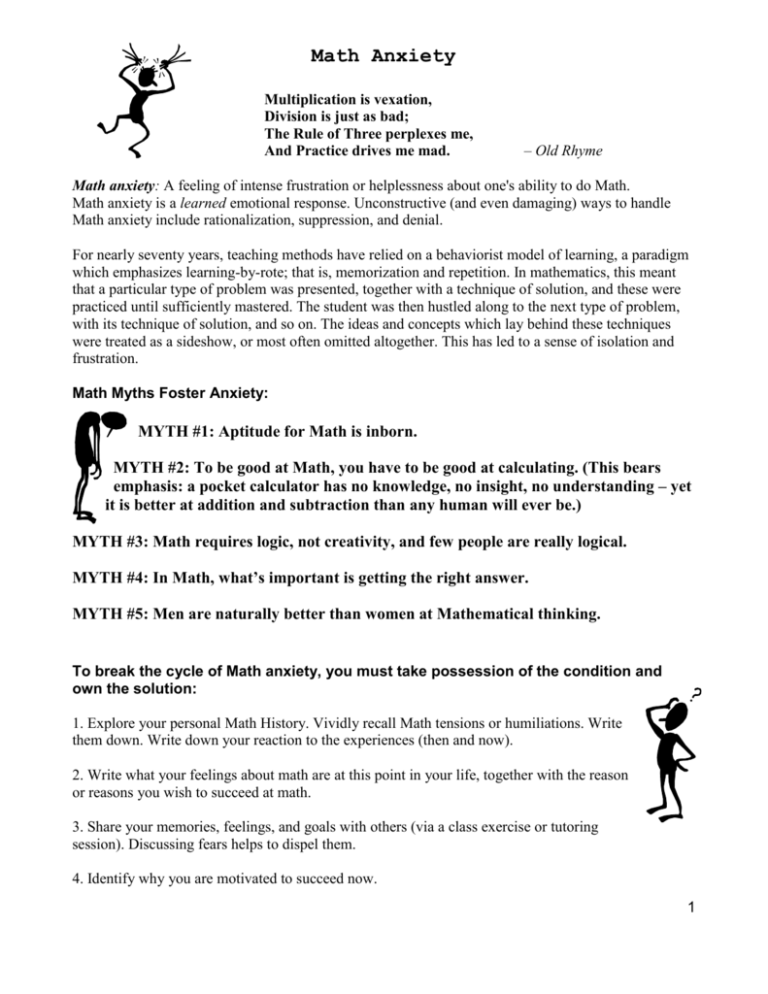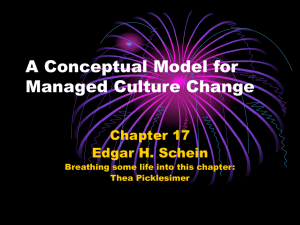Multiplication is vexation,
advertisement

Math Anxiety Multiplication is vexation, Division is just as bad; The Rule of Three perplexes me, And Practice drives me mad. – Old Rhyme Math anxiety: A feeling of intense frustration or helplessness about one's ability to do Math. Math anxiety is a learned emotional response. Unconstructive (and even damaging) ways to handle Math anxiety include rationalization, suppression, and denial. For nearly seventy years, teaching methods have relied on a behaviorist model of learning, a paradigm which emphasizes learning-by-rote; that is, memorization and repetition. In mathematics, this meant that a particular type of problem was presented, together with a technique of solution, and these were practiced until sufficiently mastered. The student was then hustled along to the next type of problem, with its technique of solution, and so on. The ideas and concepts which lay behind these techniques were treated as a sideshow, or most often omitted altogether. This has led to a sense of isolation and frustration. Math Myths Foster Anxiety: MYTH #1: Aptitude for Math is inborn. MYTH #2: To be good at Math, you have to be good at calculating. (This bears emphasis: a pocket calculator has no knowledge, no insight, no understanding – yet it is better at addition and subtraction than any human will ever be.) MYTH #3: Math requires logic, not creativity, and few people are really logical. MYTH #4: In Math, what’s important is getting the right answer. MYTH #5: Men are naturally better than women at Mathematical thinking. To break the cycle of Math anxiety, you must take possession of the condition and own the solution: 1. Explore your personal Math History. Vividly recall Math tensions or humiliations. Write them down. Write down your reaction to the experiences (then and now). 2. Write what your feelings about math are at this point in your life, together with the reason or reasons you wish to succeed at math. 3. Share your memories, feelings, and goals with others (via a class exercise or tutoring session). Discussing fears helps to dispel them. 4. Identify why you are motivated to succeed now. 1 Math Anxiety Above information from http://www.mathacademy.com/pr/minitext/anxiety/index.asp Strategies for students: Find someone who believes in you and supports your efforts Keep a Math Action Journal: Daily actions, reactions, action plans Read and review the relevant parts of the textbook before the lecture Tape record class and tutoring sessions; summarize each lesson at the end of the tape Tape record your thought processes while doing Math problems. Write one formula per note card, and an example on the back Practice former Math problems every day Predict the answer before calculating Use a calculator Collaborate with classmates/study groups Assume you will have anxiety during tests – this limits uncontrollable panic Practice controlled breathing before and during tests Don’t cram for exams. Learn in small doses. Create practice tests for study partners Do a “brain dump” to start tests (immediately write formulas at top of exam paper) Read through the whole test before beginning – watch variable weighting – do the easier problems first Box, circle, or underline your answers where appropriate Partially complete problems rather than leaving them blank Show your work on each problem even if it’s not required Review old exams immediately and again before the next test Learn WHY not just HOW to solve Math problems 2 Math Anxiety Don’t rush it! Take you time and practice in small doses. 3 Math Anxiety Strategies for instructors: Make Math relevant to students’ majors and interests Observe students’ non-verbal reactions and adjust accordingly Teach how to use calculators Assist in formation of study groups Allow tape recorders in class Give partial credit Teach how to estimate outcomes where appropriate Model steps and reasons (show and tell) Use rhymes, mnemonics, visual aids and humor Don’t humiliate Repeat, repeat, repeat (with variations) Ask students to create tests for each other Allow plenty of time on tests and quizzes (fewer problems) Assign students to keep a Math Journal (actions, reactions, action plans) Discuss Math Anxiety issues and brainstorm solutions in class Share resources with students: refer to tutoring, web pages, colleagues’ materials, old tests, etc. 4










